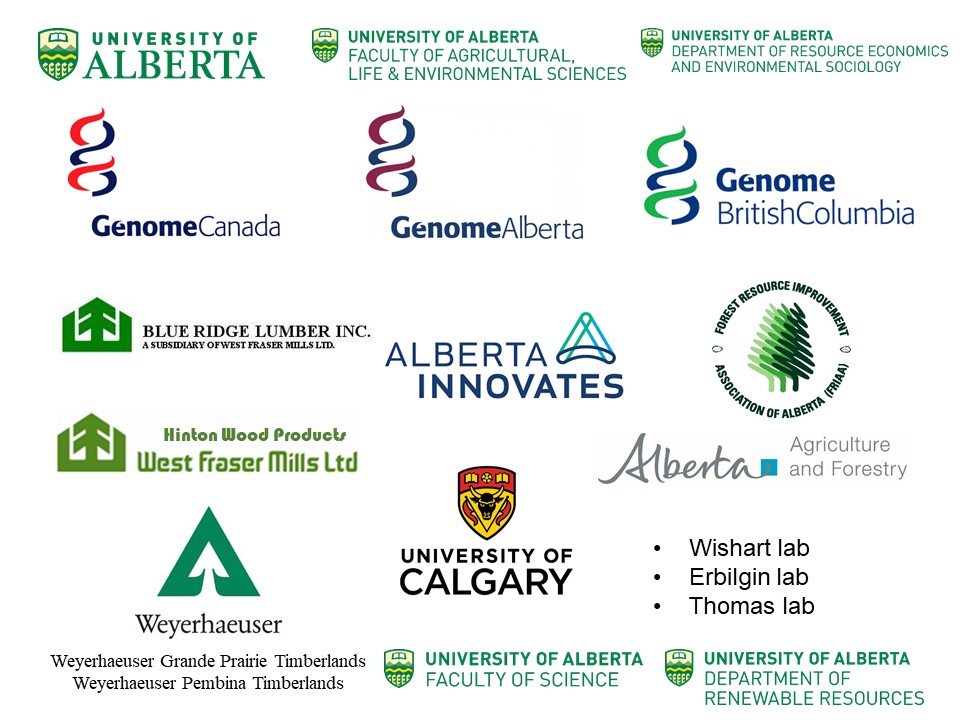RES-FOR is short for Resilient Forests
“Resilient Forests (RES-FOR): Climate, Pests & Policy – Genomic Applications”
Both productivity and sustainability of our forest ecosystems and operations are reliant on a healthy and resilient forest. However, forest health and local communities that depend on the forest industry are both under constant threat from changes in climate and climate-induced insect outbreaks. The pace of these changes is outstripping the ability for trees to adjust to these threats. Likewise, traditional tree improvement methodologies are too slow to provide well-adapted seedlings for reforestation and ultimately achieving healthy forests for the future. Thus, we propose to integrate rapidly emerging technologies (genomics and metabolic profiling) and mathematical models into existing tree breeding programs to select pest resistant and drought tolerant trees. Such integration will provide an economically and environmentally stable foundation for both industry and dependent communities throughout the Canadian landscape.
RES-FOR Goals
The goal of the RES-FOR project is to integrate genomic, metabolomic and phenotypic data into selection models that will reduce the selection time and therefore the breeding cycles in lodgepole pine and white spruce tree improvement programs in Alberta. These new integrated models will help us produce healthy, productive, and resilient forests while informing policy, determining the economic value of genomic selection and identifying social/political factors influencing the use of these cutting-edge selection strategies.
Project Description
RES-FOR is a Genome Canada $5.67 million, 4-year project led by Dr. Barb Thomas (University of Alberta), Dr. Nadir Erbilgin (University of Alberta), and Dr. Yousry El-Kassaby (University of British Columbia). RES-FOR was funded as part of the 2015 Large-Scale Applied Research Project Competition announced in December 2016.
RES-FOR Activities
RES-FOR is structured into seven central activities:
- Activity 1 – Development of genomic resources – led by Dr. Yousry El-Kassaby (University of British Columbia and Dr. Charles Chen (Oklahoma State University)
- Activity 2 – Development of LIMS and integration of phenomic data – led by Dr. David Wishart (University of Alberta)
- Activity 3 – Greenhouse trials: Phenotyping of progeny populations to pest and drought stressors – led by Dr. Barb Thomas (University of Alberta) and Dr. Nadir Erbilgin (University of Alberta)
- Activity 4 – Field Progeny Trials: Phenotypic Assessments of 35 year old progeny trials – led by Dr. Barb Thomas (University of Alberta) and Dr. Nadir Erbilgin (University of Alberta)
- Activity 5 – Analysis and genetic model development – led by Dr. Yousry El-Kassaby (University of British Columbia and Dr. Charles Chen (Oklahoma State University)
- Activity 6 – Integration into tree improvement (TI) programs – led by Dr. Yousry El-Kassaby (University of British Columbia, Dr. David Wishart (University of Alberta), Dr. Charles Chen (Oklahoma State University), and Dr. Barb Thomas (University of Alberta)
- Activity 7 – GE3LS impacts and economics – Social Sciences led by Dr. Debra Davidson (University of Alberta) and Gwendolyn Blue (University of Calgary). Economics led by Dr. Henry An (University of Alberta), Dr. Julie Cool (University of British Columbia), and Dr. Chris Gaston (University of British Columbia)
Sponsors






